Cambridge Street Tramways
History
Cambridge's 4 ft-gauge horse tramway, which was owned by the Cambridge Street Tramways Company, opened for business on the 28th October 1880. The CTCo had been formed the previous year, and had acquired powers to construct an initial set of lines on the 21st July 1879, as well as extensions to them in 1880. Although construction started in July 1879, it seems to have taken an inordinately long time before the first section was ready for opening (15 months), for reasons which are not now entirely clear.
The system, which reached its maximum extent in November 1880, totalled just 2.69 miles, and took the form of a crooked cross: one line running southeastwards from the Post Office, along St Andrews St and Regent St, through Hyde Park Corner and Hills Rd, before turning eastwards along Station Rd to the Great Eastern Railway station; the other line ran southeastwards along East Rd from its junction with Fitzroy St, through Hyde Park Corner and along Lensfield Rd, where it turned northwestwards along Trumpington Rd and Kings Parade to Market Hill, barely 300 yards from the old Post Office.
Operation of the new tramway was initially leased to a London contractor (in fact the builder of the tramway) — J F Meston — for a period of three years from the 1st January 1881; on expiry of the lease, however, the company chose to operate the system itself.
The company appears to have been quite profitable up until 1896 when its revenue was badly impacted by the appearance of the Cambridge Omnibus Company, which had been licensed to operate from the railway station, this being one of the CTCo's main sources of passengers. The tramway did not take this lying down, and in fact purchased and deployed its own omnibuses before the competition introduced theirs. The main beneficiary of unbridled competition, at least in the short term, was the fare-paying passenger, though where it persisted for a long time, the combatants usually exhausted themselves financially, and in the process, ran ever-more decrepit vehicles in an attempt to keep the operating costs down. The battle lasted until the 5th October 1900, when the two companies finally agreed not to compete against each other, though the COCo seems to have come off worst, as it folded two years later in 1902.
Meanwhile (in 1898), the company had been approached by the British Electric Traction Company Ltd, which at this time was aggressively purchasing horse and steam-operated tramways across the British Isles, with the intention of converting them to electric traction. A draft agreement between the two companies was signed on the 21st June 1898, and in 1900, control of the CTCo passed to the BETCo. However, all was not to go to plan, as the corporation had been toying with the idea of acquiring the tramway itself and converting it to electric traction, though it seems not to have been at all sure what it wanted, possibly due to the vociferousness of local objections to an electric tramway. After long and ultimately fruitless negotiations, the BETCo decided that bringing the wonders of electric transport to Cambridge was more trouble than it was worth, and on the 12th January 1904, it sold its shares in the CTCo to a new company, the Cambridge Electric Traction Syndicate, a subsidiary of the Cambridge Electric Supply Company. The CETS clearly hoped to succeed where the mighty BETCo had failed, however, it fared no better than its larger cousin, objections from local worthies, often the colleges or members thereof, proving to be insurmountable.
The tramway continued as a horse-drawn enterprise, paying moderate dividends to its shareholders up until 1904, after which the system was subjected to intense motor omnibus competition — commencing on the 9th April 1905 — which was considerably earlier than most tramway systems, possibly because the routes were short and very flat, and therefore suitable for the rather underpowered omnibuses of the day. The company did manage to see off its two main rivals — the Cambridge University and Town Motor Omnibus Company Limited (nicknamed the 'light blues') and the Cambridge Motorbus Company Limited — largely due to their poor safety records, though this was but a brief hiatus before another competitor (the Ortona Motor Company Limited) sprang up (in 1907).
The new omnibus company expanded rapidly, thanks to the corporation's willingness to grant them licences, even where the services directly competed with the tramway, the corporation seemingly oblivious to the significant income it received from the tramway in the form of rental (for maintenance of the road, by an agreement of 1892). Ironically, the consequent loss of passengers eventually led — in 1912 —to the CTCo defaulting on their quarterly rental payments to the corporation. The situation persisted for around two years, the company defaulting the entire time, until the corporation took out a winding-up order, the last horse tram running on the 18th February 1914.
Uniforms
Fortunately, the photographic record is relatively rich for such a small system, so it is possible to say with some confidence what attire was worn and how this changed over its 34-year lifespan. In common with the majority of UK horse tramways, conductors and drivers simply wore informal but robust attire — trousers, jackets, waistcoats, shirts and ties. Headgear appears to have followed the fashion of the day, predominantly the bowler hat, though this gradually gave way to the flat cap as the years wore on. No badges of any kind were worn on either the jackets or the hats.
At some point, possibly in the 1890s, large, round licence badges were introduced, and all photographs that can be securely attributed to this and subsequent decades always show conductors and drivers wearing them. A few Edwardian-era photographs appear to show crewmen wearing peaked caps that were possibly issued by the company; what badge they bore, if any, remains unknown.
A single photograph has survived which appears to show a conductor wearing a uniform (see below). All other photographs — and there are many — show conductors in informal attire, raising the possibility that uniforms may have been issued for a short while, or alternatively, that the individual depicted is not actually an employee of the tramway company.
It is currently unclear what uniforms, if any, inspectors wore, or indeed, whether the company employed them.
Further reading
For a history of the system, see: 'Cambridge Street Tramways' by S L Swingle; The Oakwood Press (1972).
Images
Horse tram drivers and conductors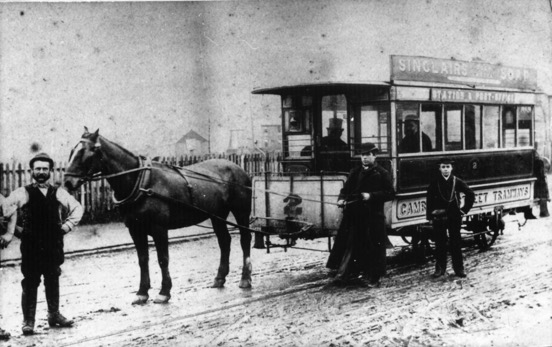
Horsecar No 2 in original single-deck condition on the Station-Post Office route — photo undated, but probably taken in the early 1880s judging by the style of the bowler hats and the state of the road. Photo courtesy of the Tramways and Light Railway Society, with thanks to David Voice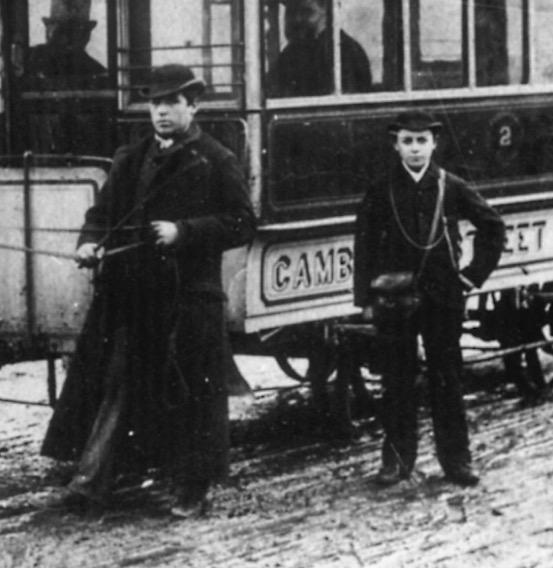
An enlargement of the above photograph showing the driver — in long, coachman's coat — together with a very youthful looking conductor.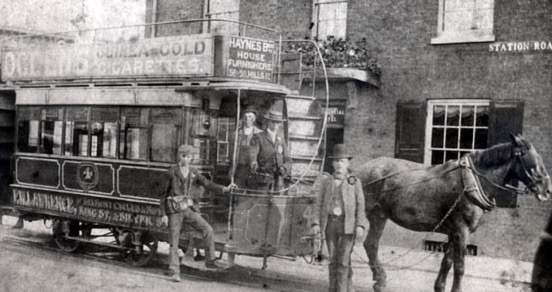
Horsecar No 4 and crew — photo undated, but possibly taken in the 1890s; No 4 was originally a single-deck vehicle. The conductor (left), the driver (on the platform), as well as the individual standing in front of the horse's rump, are all wearing round badges/licences. Photo courtesy of the Tramways and Light Railway Society, with thanks to David Voice.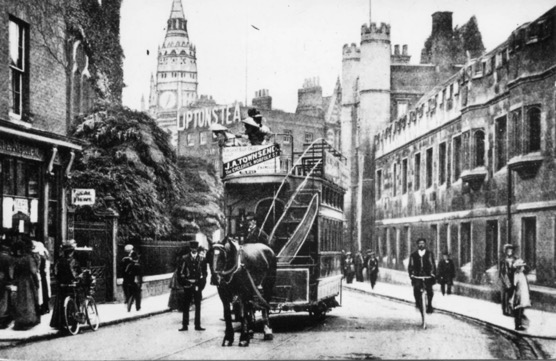
A double-deck tram waiting at the Post Office terminus — photo undated, but probably Edwardian. Photo courtesy of the Tramways and Light Railway Society, with thanks to David Voice.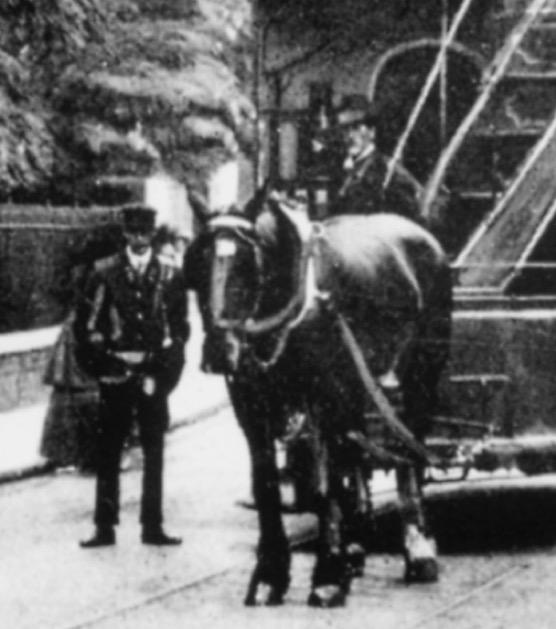
An enlargement of the above photograph; whilst the driver is wearing informal attire, the conductor, if he is indeed a conductor, appears to be wearing a uniform of sorts. All other photographs, and there are many, show conductors wearing informal attire.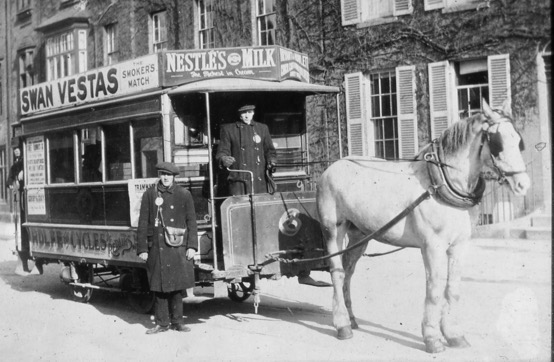
A conductor and a driver pose with Horsecar No 6 in Trumpington Street — photo undated, but possibly taken in the last week of operation closure (i.e., 1914). Photo courtesy of the Tramways and Light Railway Society, with thanks to David Voice.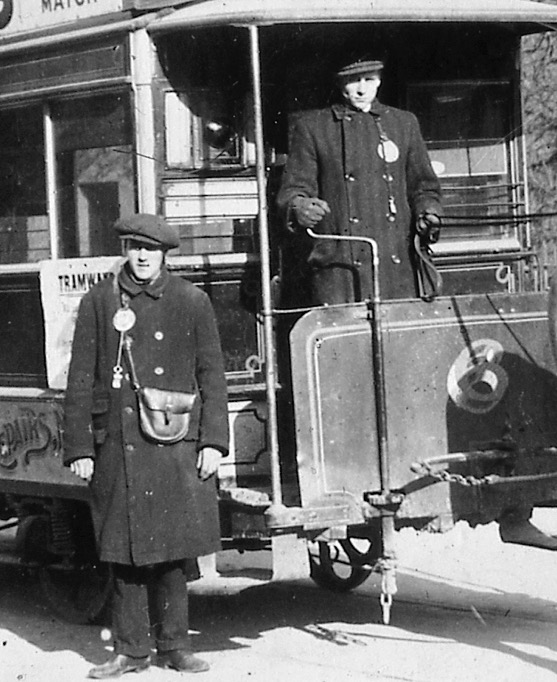
A blow up of the above photo showing the two tramwaymen, both of whom are clearly in informal, workman-like attire. Both men are wearing large, round licence badges.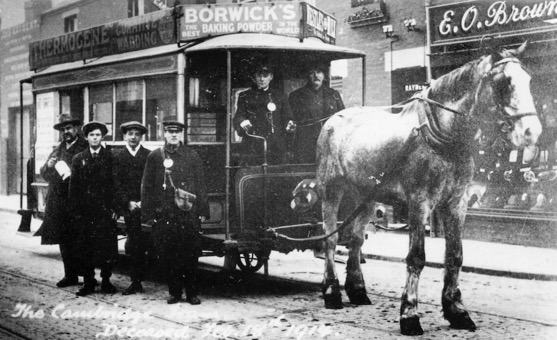
A postcard evidently sold to celebrate/commemorate the demise of services on 18th February 1914. The photograph was in all probability taken in the final days. Photo courtesy of the Tramways and Light Railway Society, with thanks to David Voice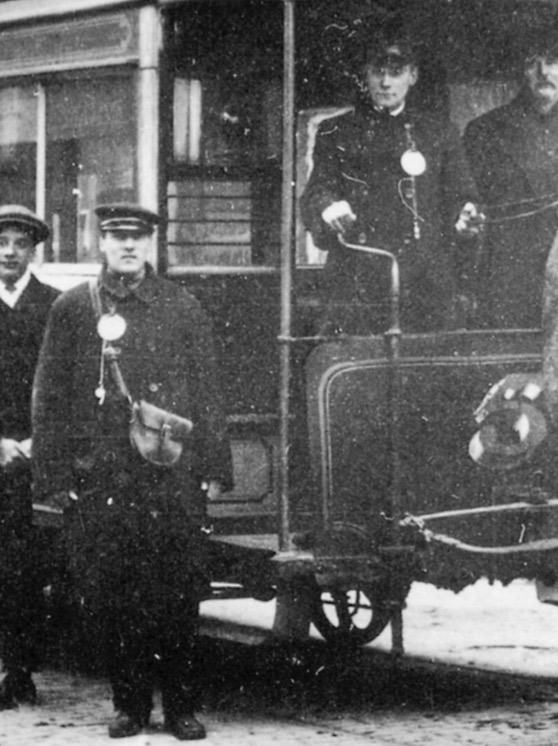
A blow-up of the above photo showing the conductor and driver, both of whom are wearing soft-top peaked caps, seemingly without badges. Once again, both men are wearing badges/licences.